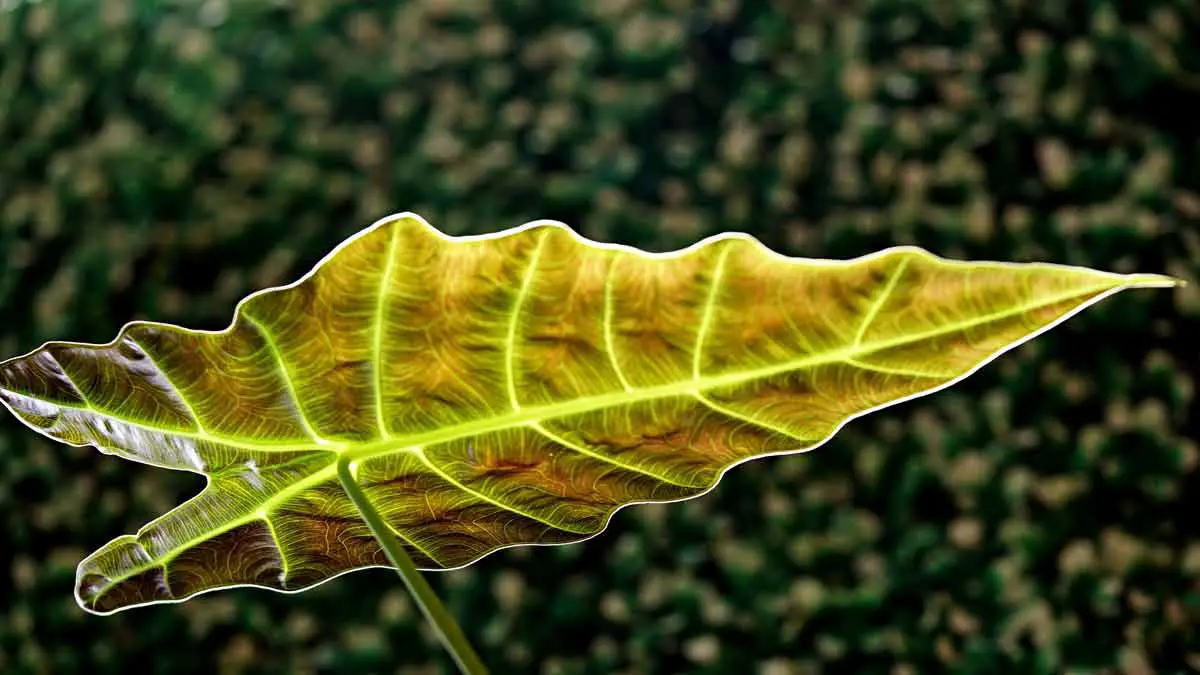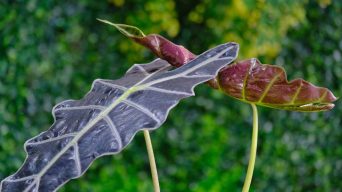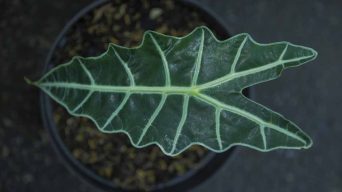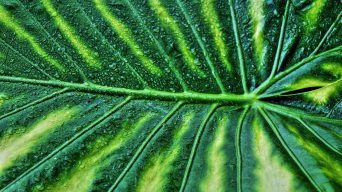Alocasia is a genus of broad-leaved rhizomatous herbaceous perennial plants in the family Araceae.
Many of the species are native to southeastern Asia and New Guinea, with a few found in Australia and Oceania.
Some Alocasia species are widely cultivated as ornamental plants. They are known for their large, glossy, veined leaves.
Some have colorful leafstalks or petioles. The inflorescence is composed of a spadix surrounded by a fleshy involucre called a spathe.
Alocasias are popular houseplants because they are easy to care for and make a dramatic statement in any indoor space.
However, even the most experienced plant parent may run into problems from time to time. One common issue with Alocasias is yellow leaves.
It can be disheartening to see your beautiful Alocasia leaves turning yellow. But don’t worry; it’s easy to fix in most cases.
Here we’ll discuss the 11 most common reasons Alocasia leaves turn yellow and how to fix them.
What Causes Alocasia Leaves to Turn Yellow? (And How To Fix It)
There are several reasons why Alocasia leaves may turn yellow.
The most common include:
1. Overwatering
Alocasias are native to tropical climates and prefer humid conditions. However, they will not tolerate sitting in water.
If the roots are constantly wet, the roots won’t be able to get the oxygen they need to function correctly. This can lead to several problems, including yellow leaves.
How To Tell if You’re Overwatering Your Alocasia
There are a few tell-tale signs that you’re overwatering your Alocasia.
These include:
- Soil that is always soggy or muddy
- Waterlogged soil that doesn’t drain well
- Roots that are mushy or starting to rot
- Yellow leaves
If you notice any of these signs, you must take action immediately.
Overwatering is one of the most common reasons for yellow leaves on Alocasias. If left unchecked, it can lead to root rot, which is fatal to the plant.
How To Fix Overwatering
If you think you’re overwatering your Alocasia, there are a few things you can do to fix the problem.
- Check the drainage. Make sure your pot has drainage holes so that water can drain out. If it doesn’t, repot the plant in a pot with drainage holes.
- Allow the soil to dry out. Water your Alocasia only when the top inch of soil is dry to the touch.
- Don’t mist the leaves. Alocasias come from a tropical climate and don’t need to be misted.
- Cut back on watering. Water your Alocasia less frequently, allowing the soil to dry.
- Check the roots. If the roots are mushy or starting to rot, you’ll need to repot the plant in fresh, dry soil.
2. Underwatering
Alocasias are drought tolerant but still need regular watering to stay healthy.
They must be watered at least once a week and more often during hot weather.
If the plant does not get enough water, the Alocasia leaves will start drooping and turning yellow.
How To Tell If You’re Underwatering Your Alocasia
There are a few signs that you’re underwatering your Alocasia.
These include:
- Soil that is dry and crumbly
- Leaves that are wilting or drooping
- Leaves that are dry or crispy
- Yellow leaves
If you notice any of these signs, you must take action immediately.
An underwatered Alocasia is more likely to succumb to pests and diseases.
How To Fix Underwatering
If you think you’re underwatering your Alocasia, there are a few things you can do to fix the problem.
- Water the plant more frequently. During hot weather, you may need to water your Alocasia every day.
- Check the soil. Make sure the soil is moist but not soggy. If it’s too dry, add water. If it’s too wet, let the excess water drain out.
- Water deeply. When you do water, make sure to water deeply. This will help the plant develop strong roots.
- Use a humidity tray. If the air is too dry, consider using a humidity tray. This will help keep the leaves from drying out.
3. Lack of Light
Alocasias need bright indirect light to thrive.
If the plant is not getting enough light, the leaves will start to turn yellow.
How To Tell If Your Alocasia Is Not Getting Enough Light
There are a few signs that your Alocasia is not getting enough light.
These include:
- Leaves that are turning yellow
- Leaves that are small or stunted
- Slow growth
If you notice any of these signs, you must take action immediately.
Lack of light is one of the most common reasons for yellow Alocasia leaves.
How To Fix Lack of Light
If you think your Alocasia isn’t getting enough light, there are a few things you can do to fix the problem.
- Move the plant to a brighter location. Alocasias need bright indirect light. If possible, move the plant to a spot near a window.
- Use grow lights. Consider using grow lights if you can’t move the plant to a brighter location.
- Increase the amount of light gradually. If you’re using grow lights, increase the light gradually to avoid shocking the plant.
- Place in an east- or west-facing window. If you’re using grow lights, place the plant in an east- or west-facing window.
4. Too Much Sunlight
While Alocasias need bright light to thrive, they can’t tolerate too much direct sunlight.
Alocasia needs bright indirect sunlight. If the plant is getting too much direct sunlight, the leaves will start to turn yellow.
How To Tell If Your Alocasia Is Getting Too Much Sunlight
There are a few signs that your Alocasia is getting too much sunlight.
These include:
- Leaves that are turning yellow
- Leaves that are dry or crispy
- Brown spots on the leaves
If you notice any of these signs, you must take action immediately.
Too much sunlight can cause irreversible damage to the leaves.
How To Fix Too Much Sunlight
If you think your Alocasia is getting too much sunlight, there are a few things you can do to fix the problem.
- Move the plant to a shadier location. Alocasias need indirect sunlight. If possible, move the plant to a spot where it will get some shade during the day.
- Use grow lights. Consider using grow lights if you can’t move the plant to a shadier location.
- Decrease the amount of light gradually. If you’re using grow lights, gradually decrease the light to avoid shocking the plant.
- Place in an east- or west-facing window. This will help filter the light and prevent the leaves from getting scorched.
5. Nutrient Deficiencies
Nutrients are essential for plant growth.
If a plant is lacking in nutrients, it will start to show signs of stress. This can include yellow leaves.
Nutrient deficiencies can be caused by several things, including poor soil, improper fertilization, and insufficient light.
How To Tell If Your Alocasia Has A Nutrient Deficiency
There are a few signs that your Alocasia has a nutrient deficiency.
These include:
- Yellow leaves
- Slow growth
- Small or stunted leaves
- Brown spots on the leaves
If you notice any of these signs, you must take action immediately.
A nutrient deficiency can stress the plant and lead to other problems.
How To Fix A Nutrient Deficiency
If you think your Alocasia has a nutrient deficiency, there are a few things you can do to fix the problem.
- Use a balanced fertilizer. Fertilize your Alocasia with a balanced fertilizer according to the package directions.
- Add compost to the soil. Compost is an excellent source of nutrients for plants. You can add compost to the soil around your Alocasia or use it as a fertilizer.
- Use a soil test kit. A soil test kit will help you determine which nutrients are lacking in the soil. You can then add the appropriate amendments to the soil.
6. Overfertilization
While fertilization is essential for plant growth, too much fertilizer can be just as harmful as too little.
When an Alocasia is overfertilized, the plant leaves will start to turn yellow. This is because the plant is unable to absorb all of the nutrients.
Overfertilization can lead to other problems, such as root burn and leaf scorch.
How To Tell If Your Alocasia Is Overfertilized
There are a few signs that your Alocasia plant is overfertilized.
These include:
- Yellowing leaves
- Brown spots on the leaves
- Burnt or dead leaves
- Slow growth
If you notice any of these signs, you must take action immediately.
Overfertilization can stress the plant and lead to other problems.
How To Fix Overfertilization
If you think your Alocasia is overfertilized, there are a few things you can do to fix the problem.
- Flush the soil. Flushing the soil with water will help remove some of the excess fertilizer. To do this, water the plant deeply and then let the water drain out.
- Don’t fertilize for a while. Once you’ve flushed the soil and repotted the plant, don’t fertilize for a while. This will give the plant a chance to recover.
- Use a balanced fertilizer. If you must fertilize, use a balanced fertilizer according to the package directions.
- Repot the plant. Repotting the plant in a fresh, sterile potting mix will also help remove excess fertilizer.
7. Low Humidity
Alocasia plants like high humidity.
If the air is too dry, it can cause the leaves to turn yellow and brown. This is because the plant is losing moisture through its leaves.
Low humidity can also lead to other problems, such as leaf drop and stunted growth.
How To Tell If Your Alocasia Has Low Humidity
There are a few signs that your Alocasia has low humidity.
These include:
- Yellowing leaves
- Brown spots on the leaves
- Dry or wilted leaves
- Stunted growth
If you notice any of these signs, you must take action immediately.
How To Fix Low Humidity
If you think your Alocasia has low humidity, there are a few things you can do to fix the problem.
- Group plants together. Grouping plants together will create a more humid microclimate.
- Use a humidifier. A humidifier will add moisture to the air around your Alocasia.
- Place the plant on a pebble tray. A pebble tray is a tray of rocks or pebbles with water. The water will evaporate and add moisture to the air.
- Mist the leaves. Misting the leaves with water will also add moisture to the air.
8. Temperature Stress
Alocasias like warm, humid conditions.
If the temperature is too cold, it can cause the leaves to turn yellow and brown. This is because the plant is unable to photosynthesize properly in the cold.
Also, if the temperature is too hot, it can cause the leaves to turn yellow. This is because the plant is losing moisture through its leaves.
How To Tell If Your Alocasia Is Stressed By Temperature
There are a few signs that your Alocasia plant is stressed by temperature.
These include:
- Yellowing leaves
- Brown spots on the leaves
- Dry or wilted leaves
- Stunted growth
If you notice any of these signs, you must take action immediately.
How To Fix Temperature Stress
If you think your Alocasia plant is stressed by temperature, there are a few things you can do to fix the problem.
- Move the plant to a warmer or cooler location. If the temperature is too hot, move the plant to a cooler place. If the temperature is too cold, move the plant to a warmer location.
- Adjust the humidity. If the temperature is too hot, increasing the humidity will help. If the temperature is too cold, decreasing the moisture will help.
- Use a heat lamp. If the temperature is too cold, you can use a heat lamp to warm the area around the plant.
- Use a fan. If the temperature is too hot, you can use a fan to cool the area around the plant.
9. Pest Infestation
Pests can cause severe problems for Alocasias.
If the plant is infested with pests, it can affect the plant’s ability to photosynthesize. This may lead to the alocasia leaves exhibiting browning and yellowing.
Common pests that affect Alocasias include mealybugs, scale insects, and spider mites.
How To Tell If Your Alocasia Has A Pest Infestation
There are a few signs that your Alocasia has a pest infestation.
These include:
- Yellow or brown leaves
- Leaves with holes in them
- Sticky leaves
- White fuzzy growth on the leaves
If you see any of these signs, you must take action immediately. The longer you wait, the worse the infestation will get.
How To Get Rid Of Pests On Alocasias
If you think your Alocasia has a pest infestation, you can do a few things to get rid of the pests.
- Remove by hand. If the infestation is not severe, you can try to remove the pests by hand or with a cotton swab dipped in rubbing alcohol.
- Use insecticidal soap. Insecticidal soap will kill the pests on contact.
- Use horticultural oil. Horticultural oil will smother the pests and suffocate them.
- Use neem oil. Neem oil is a natural pest repellent.
- Remove the affected leaves. If the infestation is severe, you may need to remove the affected leaves.
10. Root Rot
Root rot is a severe problem for Alocasias.
If the roots of the plant are rotted, it can affect the plant’s ability to uptake water and nutrients. This can cause the leaves to turn yellow and brown.
A fungus causes root rot. The fungus thrives in wet, humid conditions.
How To Tell If Your Alocasia Has Root Rot
There are a few signs that your Alocasia has root rot.
These include:
- Yellow or brown leaves
- Drooping leaves
- Stunted growth
- A foul smell coming from the root area
If you see any of these signs, you must take action immediately. The longer you wait, the worse the problem will get.
How To Fix Root Rot
If you think your Alocasia has root rot, there are a few things you can do to fix the problem.
- Remove the affected roots. You must remove the affected roots and replant the Alocasia in a fresh potting mix.
- Use a fungicide. There are many different fungicides available. You will need to follow the instructions on the label carefully.
- Improve drainage. Root rot is often caused by poor drainage. If you improve the drainage in the pot, it will help to prevent the problem from happening again.
- Use a well-draining potting mix. If you are replanting your Alocasia, use a well-draining potting mix.
11. Disease
Many different diseases can affect Alocasias.
Some of the most common include fungal diseases, such as powdery mildew and leaf spot.
Diseases can cause severe problems for Alocasias.
They can affect the plant’s ability to photosynthesize. This can cause the leaves to turn yellow and brown.
How To Tell If Your Alocasia Has A Disease
There are a few signs that your Alocasia has a disease.
These include:
- Brown or yellow leaves
- Wilting leaves
- Black spots on the leaves
- White powder on the leaves
If you see any of these signs, it’s important to take action immediately. The sooner you treat the problem, the better your chance of saving your plant.
How To Treat Diseases In Alocasias
If you think your Alocasia has a disease, you can do a few things to treat the problem.
- Use a fungicide. There are many different fungicides available. You will need to follow the instructions on the label carefully.
- Remove the affected leaves. If the infestation is severe, you may need to remove the affected leaves.
- Improve air circulation. Diseases often thrive in humid, stagnant conditions. If you improve the air circulation around your plant, it will help to prevent the problem from happening again.
- Avoid overwatering. Over watering can lead to damp conditions that are perfect for diseases to thrive in. Be sure to water your Alocasia only when the soil is dry.
Final Thoughts
Many different factors can cause Alocasia leaves to turn yellow.
If you see your Alocasia leaves turning yellow, it’s important to take action immediately.
The sooner you diagnose the problem, the better your chance of saving your plant.
Alocasia care can be challenging.
But it’s definitely worth it! These plants are so beautiful and unique.
If you take the time to learn about their care needs, you’ll be rewarded with a healthy, happy plant.







